|
Archive for the year 2010
Music for December 2010, 1: "Auld Lang Syne" in First Pieces .
 |
This song is known around the world and is often sung to celebrate the start of the New Year at the stroke of midnight. Its Scots title may be translated into English literally as "old long since", or more idiomatically, "long long ago","days gone by" or "old times". Consequently "For auld lang syne", as it appears in the first line of the chorus, is loosely translated as "for (the sake of) old times".
Singing the song on New Year's Eve very quickly became a Scots custom that soon spread to other parts of the British Isles. As Scots (and other Britons) emigrated around the world, they took the song with them.
--from Wikipedia.com
Write your comments at the facebook group |
Music for December 2010, 2, for Australia Day, January 26:
"Click Go the Shears" in Level Four
This song details a day's work for a sheep shearer in the days before machine shears. The enduring popularity of this song reflects the traditional role that the wool industry has played in Australian life. The song describes the various roles in the shearing shed, including the "ringer", the "boss of the board", the "colonial experience man" and the "tar boy". After the day's shearing, the "old shearer" takes his cheque and heads to the local pub for a drinking session.
The tune is an adaptation of the American Civil War song "Ring the Bell, Watchman" by Henry Clay Work.
--from Wikipedia.com
| 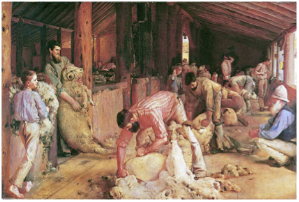
Shearing the Rams
by Australian painter, Thomas William Roberts
|
Write your comments at the facebook group
November Music for the Holidays, 1: "Un Flambeau, Jeannette, Isabelle /
Bring a Torch, Jeanette, Isabella" in Primer Level
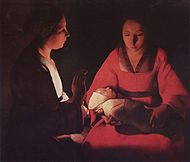
Le Nouveau-Né
by Georges de la Tour
|
This carol was first published in 1553 in France, and was subsequently translated into English in the 18th century. The song was originally not a song to be sung at Christmas, but rather dance music for French nobility.
In the carol, visitors to the stable have to keep their voices down so little Jesus can enjoy his dreams. To this day in the Provence region, children dress up as shepherds and milkmaids, carrying torches and candles to Midnight Mass on Christmas Eve, while singing the carol.
The painter Georges de La Tour painted a nativity scene based on the carol.
--from Wikipedia.com
|
Write your comments at the facebook group
November Music for the Holidays, 2: "Ner Li /
I Have a Candle" in Level Three .
This Hanukah song has become one of my favorites for its simplicity and innocence. A child identifies with just one of the eight Hanukkah candles whose light shines bright and long.
Write your comments at the facebook group |
 |
November Music for the Holidays, 3: "Lulajze Jezuniu /
Sleep Little Jesus" Level Two .
 |
This Polish Carol was requested on this site's facebook group. It begins, "Sleep little Jesus, my little pearl" and portrays the tenderness all mothers have as they sing their children to sleep. Aside from the sheer beauty of the melody, this particular carol is memorable because Chopin used it in one of his pieces. His Scherzo No. 1 in B minor, op. 20 calmly quotes the lullaby preceded and followed by two fast, agitated sections. Writing in Vienna, Austria, Chopin was in a nostalgic mood, thinking of his native Poland as he spent his first Christmas away from home. In this video, the tune appears at 4 minutes and 30 seconds.
|
Write your comments at the facebook group
New Music for Halloween: "Toccata"
from Toccata and Fugue in D Minor in Level Four .
This piece has been arranged for us by Karolina Szurek. It is a favorite in the States at Halloween because of its frightening power. However Karolina writes, "Do you know the French cartoon series "Il Etait Une Fois... L'Homme" (in English, "Once Upon a Time... Man")? Toccata is the main theme in that cartoon and that's why all my students know it so well. It's from 1978 but it's still very popular in Poland."
By the way, the Toccata and Fugue were oringinally thought to be by Bach, but some scholars are now questioning whether he really wrote them. | 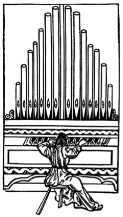
|
Write your comments at the facebook group
New--and early--October Music for Thanksgiving:
"For the Beauty of the Earth" in Level Two

|
I love this piece! It's clearly a hymn of Thanksgiving, but it is nondenominational, and appropriate to any number of religions. There is also a modern appreciation for the nature that surrounds us on our fragile planet. I thought I would introduce this song well before the U.S. Thanksgiving holiday so my visitors would have plenty of time to master it. Happy early Thanksgiving!
BSome people may have heard this with a different tune. See (Youtube). And some may have heard this with different words.
|
Write your comments at the facebook group
New Music for September: "In the Field there Stood a Birch Tree"
in First Pieces .
This traditional Russian song was used by Tchaikovsky in the fourth movement of his fourth symphony. The movement begins with a tremendous fanfare, after which the birch tree theme is played softly by the woodwinds (listen to the accompanying video). The lyrics begin:
See the lovely birch in the meadow,
Curly leaves all dancing when the wind blows.
Loo-lee-loo, when the wind blows,
Loo-lee-loo, when the wind blows.
| 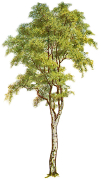
|
Write your comments at the facebook group
More New Music for September: Gurlitt's "Dance" in Keyboard Classics
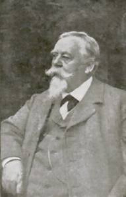
Cornelius Gurlitt
|
Cornelius Gurlitt (1820 - 1901) made a name for himself as an organist in Leipzig, Germany, the city where JS Bach also played organ and wrote many of his major works, and in Rome, Italy, where he also studied painting. On his return to his native Germany, the Duke of Augustenburg engaged him as teacher for three of his daughters. He very much loved music but wanted music to educate people, not just to entertain them. So as a music teacher he wrote many pieces like this 'Dance'.
--from Wikipedia |
Write your comments at the facebook group
New Music for August: Los Pollitos / The Chicks in Level Two .
This is a Spanish children's song popular in many countries and sung with many variations. Here's a translation:
Baby chicks say "pio, pio, pio" when they are hungry, when they are cold.
The hen looks for wheat and corn; she gives them their food, and keeps them warm.
Under her wings, tucked in and snuggled tight, The chicks fall sleep until daylight.
| 
|
Write your comments at the facebook group
More New Music for August: Haydn's "Allemande" in Keyboard Classics

Franz Joseph Haydn
|
"Allemande" is the French word for "German." The "Allemande" then is a typically German dance, but the way it sounded changed a lot over the centuries. During Franz Joseph Haydn's time "Allemandes" referred to dances in triple meter, some actually anticipating the waltz.
It's possible that the names of the square dance figures, "allemande right" and "allemande left" came from these German dances. |
Write your comments at the facebook group
New Music for July: Tarantella Napoletana in Primer and Level Four.
This is The Tarantella for many Italian-Americans. It is named after the the tarantula spider (in Italian, "tarantola") and its place of origin, Naples. Yet the Tarantella may be danced to many melodies, and many composers have composed their own. The Tarantella is in a fast 6/8 meter, though the primer version here has been changed to 3/4 for ease of reading. Legend has it that dancing this strenuous dance would be an antidote to the tarantula's bite.
| 
|
Write your comments at the facebook group
New Music for June: "Sakura" in Level Three
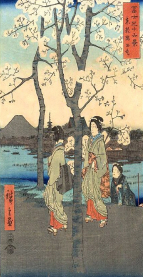
|
"Sakura" is a traditional Japanese folk song depicting spring, the season of the cherry blossom. The song was first composed during the Edo period for children learning to play the koto (see picture below). The koto is derived from the Chinese guzheng. Originally, the lyrics "Blooming cherry blossoms" were attached to the melody of "Sakura." The song has been popular since the Meiji period, and the lyrics in their present form were attached then. It is often sung in international settings as a song representative of Japan.
--from Wikipedia
Listen to "Sakura" played on a guzheng.
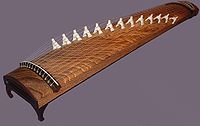
Japanese koto
|
Write your comments at the facebook group
New Music for June: Slavonic March in Level One.
The Slavonic March (also known as Marche Slave), is an orchestral composition by Tchaikovsky. In June 1876, following incidents in which Turkish soldiers killed a large number of Christian Slavs who were rebelling against the Ottoman Empire, Serbia declared war on Turkey. Many Russians sympathized with those they considered to be their fellow Slavs and sent volunteer soldiers and aid to assist the Kingdom of Serbia.
A close friend of Tchaikovsky asked him to compose a piece for a concert benefiting the wounded Russian volunteers. In a burst of patriotism, Tchaikovsky composed and orchestrated what was first known as the "Serbo-Russian March" (later to be known as "Marche Slave") in only five days. The piece was premiered in Moscow on November 17, 1876 to a warm reception.
--from Wikipedia
Listen to Tchaikovsky's original orchestral version.
| 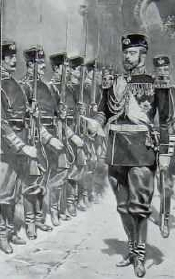
|
Write your comments at the facebook group
New Music for May: "Oh! Susannah" in Level Two

|
"Oh! Susannah" was composed by Stephen Collins Foster who was born in what was then called Lawrenceville, but what is now part of my home town Pittsburgh, Pennsylvania. Also like me, he was the baby of the family. In 1846, Foster moved to Cincinnati, Ohio and became a bookkeeper with his brother's steamship company. While in Cincinnati, Foster penned his first successful songs, among them "Oh! Susanna". This song would prove to be the anthem of the California Gold Rush from 1848 to 1849. If you come to Pittsburgh you should see the Stephen Foster Museum at the University of Pittsburgh, curated by my friend, Deane Root. |
Write your comments at the facebook group
New Music for May: Schubert's "Ave Maria" (complete) Level Four.
This is the complete version of the very popular Level Three piece on my site. It was originally composed as a setting of a song from Walter Scott's poem "The Lady of the Lake." In Scott's poem the character Ellen Douglas, the "Lady" of "the Lake" (Loch Katrine in the Scottish Highlands) has gone with her father to hide in the "Goblin's cave" nearby to avoid drawing the vengeance of the King on their host, Roderick Dhu. While there she sings a prayer addressed to the Virgin Mary, calling upon her for help.
--from Wikipedia
| 
|
Write your comments at the facebook group
Music for April, 2010: Theme to "Raindrop" Prelude by Chopin in Level Four.

Portrait of Chopin by Eugène Delacroix
|
The theme to this prelude was arranged for you by Karolina Szurek in honor of the 200th anniversary of Chopin's birth.
This prelude is one of a set of preludes in Opus 28. It "is the longest of the collection of short preludes, but it's known for reasons other than its length: The prelude is noted for its repeating A-flat [in this arrangement, G], which appears throughout the piece. The A-flat sounds like raindrops to many listeners, giving Op. 28 No. 15 a nickname: The "Raindrop" Prelude. The "Raindrop" Prelude is associated with romance, having appeared as the musical backdrop in romantic film scenes -- its stormy middle section has even been used in Halo 3, a war video game."
--from the WNYC website
|
Music for April, 2010: "Simple Gifts" in Level Two.
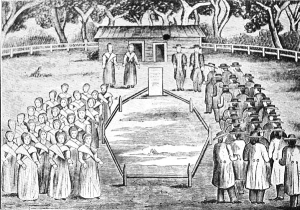
This drawing was published in Two Years Experience
among the Shakers, by David Rich Lamson, in 1848.
|
"Simple Gifts was largely unknown outside of Shaker communities until it became world famous thanks to its use in Aaron Copland's score for Martha Graham's ballet, Appalachian Spring, first performed in 1944. Copland used "Simple Gifts" a second time in 1950 in his first set of Old American Songs for voice and piano, which was later orchestrated.
The composer of "Simple Gifts," Elder Joseph Brackett was born in Cumberland, Maine, on May 6, 1797. He first joined the Shakers at Gorham, Maine, when his father's farm helped to form the nucleus of a new Shaker settlement. In 1819, Joseph moved with the other Shakers to Poland Hill, Maine, where he learned that he could sing very well. He later served as first minister of Maine Shaker societies, as well as Church Elder at New Gloucester, Maine, now known as Sabbathday Lake, the last remaining Shaker community. Elder Joseph Brackett died on July 4, 1882."
--Wikipedia.com
|
See more postings at the Free Piano Music! archive for 2011, for 2012, for 2013 and for 2014
See recent postings at the Free Piano Music! current home page.
|
|



















